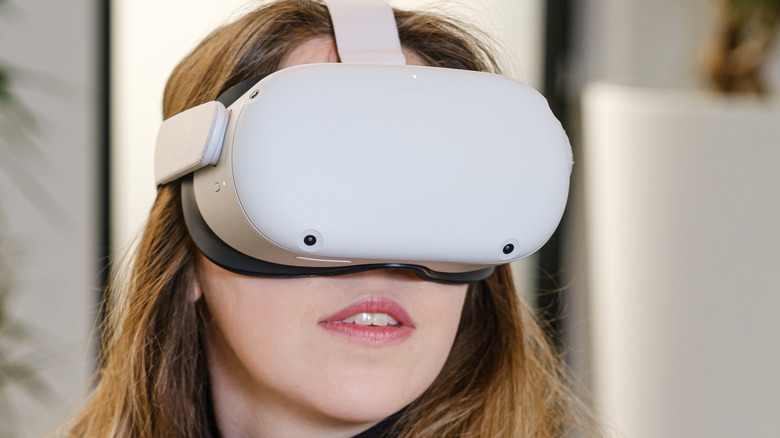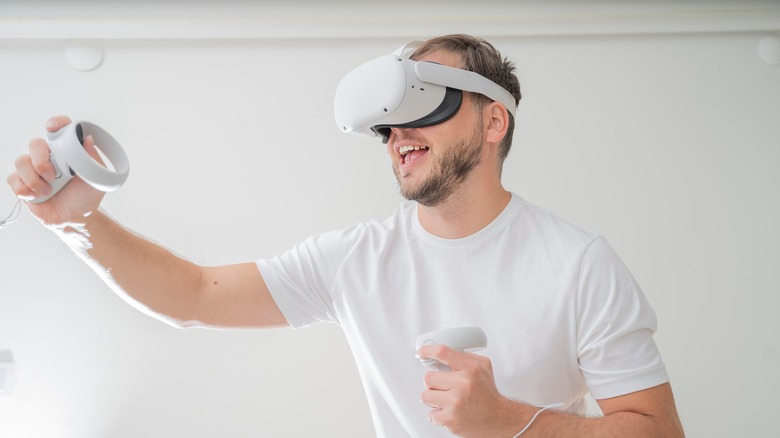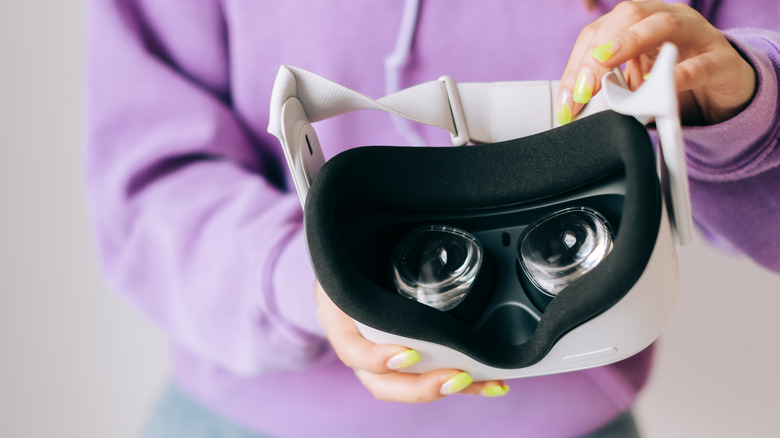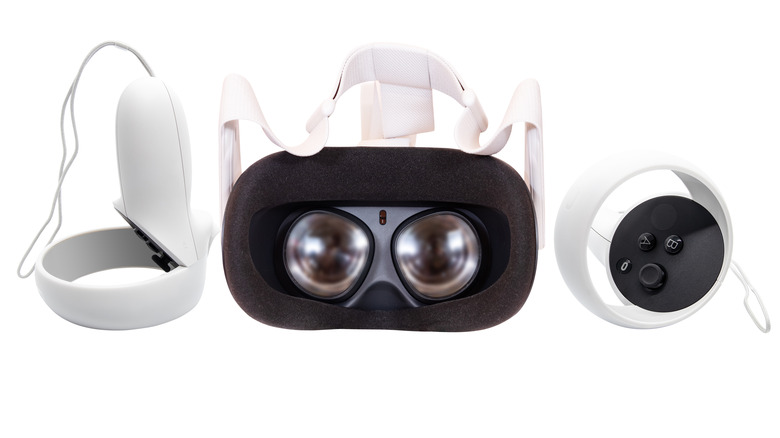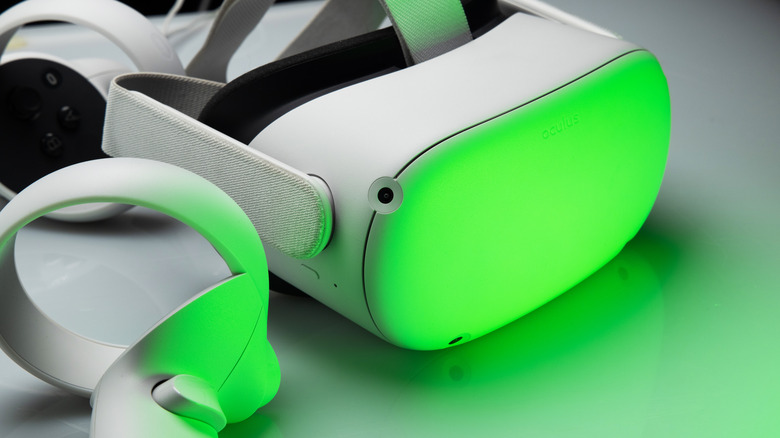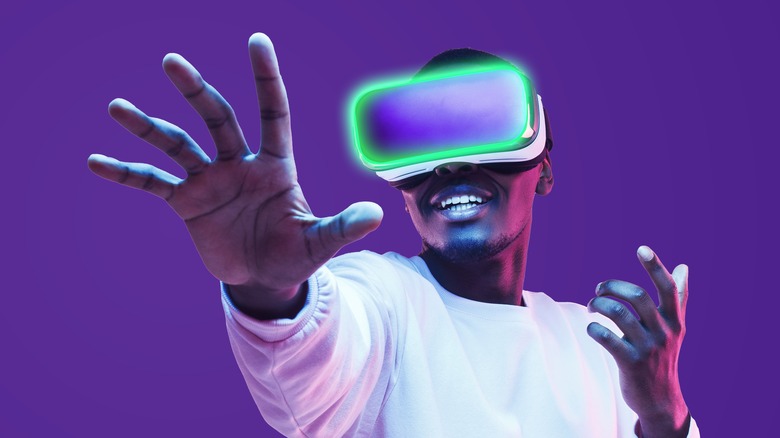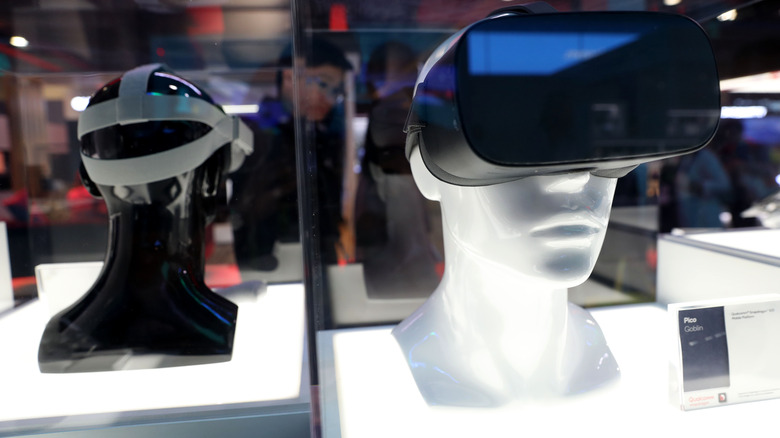The Biggest Features We Need In A Meta Quest 3
When it launched, Meta Quest 2 was a game-changer in the virtual reality space. Launched back in late 2020 as the Oculus Quest 2, it was the most capable standalone VR headset to date and convinced millions (via Francisco Jeronimo) to finally make the jump from meatspace into a world of Beat Saber combos and metaverse communities. With a friendly price point, coupled with the fact that you don't need a beefy gaming PC to use it, the Quest 2 quickly became a hit.
Well, we're now going on three years since the Quest 2 first launched. A lot has changed in that time, starting with the name of the product. The company formerly known as Facebook is now dubbed Meta and is mostly focused on virtual reality and augmented reality. As a result, the Oculus Quest 2 became the Meta Quest 2. That corporate pivot also changed the landscape of the VR market, with more companies now racing to beat Mark Zuckerberg for domination of a new digital frontier.
Since becoming Meta, the trajectory of the company has been a cavalcade of weird decisions, but its saving grace might just be the follow-up to the Quest 2. We've received confirmation that Meta plans to release a new consumer-grade headset in 2023. That device will most likely be the Quest 3, and it's an opportunity for Meta to retake the VR space amid hot competition from the likes of Sony and HTC.
There is, to understate the issue, plenty of room for improvement with the Meta Quest 3. From hardware to software and ergonomics to processing power, here are the biggest features and changes we need to see in the Meta Quest 3.
Better weight distribution
The biggest upgrades we need in Meta's next consumer-focused VR headset are also the most basic. Let's start with the essentials of what we need in a Quest 3, beginning with the physical experience of wearing it. The most important thing over long sessions in VR is comfort. After all, a bigger battery or more software features won't matter if your neck and face are sore after only 30 minutes. The biggest upgrade the Quest 2 needs is weight distribution for better ergonomics.
The Quest 2 isn't too uncomfortable, but it is front-heavy, with all of its components crammed into the visor. While this does make it incredibly portable, users who don't want to have neck cramps after long play sessions have been forced to turn to third-party accessories that focus more weight on the back of the head. That is not acceptable for a product at this price point and needs to be fixed in the Quest 3.
Better head strap
The head strap on the Quest 2 is far and away the worst aspect of that headset's design. The design of the three-pronged, elastic strap has often been compared to a thong, and it quite frankly sucks. Quest 2 owners who want to keep the headset in place while slashing out a round of Beat Saber or using exercise apps like Supernatural have been forced to shell out for Meta's Elite Strap (which has issues of its own) or turn to third-party accessories in order to get decent head straps, and the Quest 3 needs to come with a better solution out of the box.
Luckily, Meta made steps to address this issue with its newest, much pricier VR offering, the Quest Pro. That device has a more traditional strap that includes a padded, adjustable head back. Meta needs to bring that level of design down to a more entry-level price point on the Quest 3, especially if the company wants to encourage mass adoption for the VR-focused future it's been championing. There have been plenty of Metaverse setbacks already, but the easiest way to make people give up on VR is to make it physically unbearable.
Better face cushioning
The Meta Quest 2's face cushion is notoriously bad. It's basically a band of cheap foam that soaks up sweat like a sponge and gets absolutely foul with continued use. There's no good way to clean it, either. Meta ended up briefly putting sales of the Quest 2 on pause when the foam caused allergic reactions in some users and reshipped the units with a silicon attachment that goes over the foam. That flimsy, flappy band of silicon is a bit of a slapdash fix for something so core to the user experience of a VR headset, and the Quest 3 absolutely needs to have a premium feeling face pad out of the box. Once more, this is an issue that forces users to turn to the third-party accessory market for something that should have been good enough out of the box.
This is one upgrade we don't want to see copied from the Quest Pro, which opted to leave space around the eyes for real-world peripheral vision, presumably so office workers can see what's going on outside the VR realm. There is an included light blocker, but the Quest 3 should be focused on gaming, and its pad should therefore cover the entire face, blocking the outside entirely from view.
Better displays and lenses
The displays on the Quest 2 are adequate. Each unit is equipped with a pair of 90 Hz, 1832 x 1920 pixels-per-eye LCDs (via Meta). That's perfectly great for mobile-grade game visuals, basic web browsing, and media consumption. But they're already feeling a little dated, and since displays are part of a VR headset you'll be putting millimeters from your eyeballs every time you use it, Meta should not cheap out on the Quest 3's panels. Not only would higher resolution panels using OLED technology make for a more immersive experience more suited to PC-based VR gaming, but they'll also reduce eye strain.
Additionally, better lenses will make all the difference. Recent leaks suggest that the same pancake lenses seen in the Quest Pro are coming to the Quest 3, which would be a welcome addition. We'd also like to see better eye spacing adjustment, since the Quest 2 is limited to three presets, along with a greater field of vision that allows a more immersive experience than the Quest 2's scuba mask-like viewing.
Better hand tracking
The Quest 2 is equipped with hand-tracking technology that maps your digits in meatspace and allows you to use gestures inside VR space. Hand tracking in VR is a nifty idea in theory, allowing users to interact more naturally with a virtual environment and stop fumbling around for handheld controllers. As Meta moves toward what it hopes will be a future of VR ubiquity with the goal of ultimately making headsets the size of glasses, controllers will become a thing of the past.
However, as implemented on the Quest 2, the hand-tracking feature can be finicky and cumbersome. The headset constantly loses track of users' hands if they move outside the limited view of its cameras (which happens quite frequently if you're doing anything that isn't directly in front of your face), and even the slightest movement can trigger accidental interactions. The Quest 3 needs to correct these issues, and it might even be a good idea to sell hand-tracking gloves as an add-on item so those who want to go all-in on controller-free VR don't have to rely on the device's cameras alone.
A better mixed reality experience
As Meta continues to go all-in on its vision of a metaverse future, mixed reality and augmented reality have become central to its aims. The Quest Pro, Meta's enterprise-focused headset, centers around the ability to interact with parts of the physical world alongside virtual layers. Surprisingly, Meta has even brought aspects of mixed reality to the years-old Quest 2, which was recently updated with a mixed-reality mode that allows native apps, such as the browser, to run over a rendering of the world around you. Some third-party apps have already released updates to integrate this functionality.
However, since the Quest 2 lacks color cameras, those real-world environments are rendered in grayscale. The most fundamental improvement the Quest 3 should include to aid with mixed and augmented reality is the addition of more and better cameras. The Quest 2 comes with four black and white cameras at each corner of the backplate. These are fine for tasks like setting a virtual boundary or using passthrough mode to grab a drink of water between Supernatural boxing sessions, but they're otherwise far from ideal. What other device is using grayscale cameras today?
The Meta Quest 3 should include sharp, color cameras to make mixed reality feel more natural, and it should include more of them to make the device more functional for things like the aforementioned hand tracking.
A beefier processor
The most important component of a VR headset is the processor. After all, the most futuristic display technology and advanced mixed reality features mean nothing if the chip inside can't keep up. The Quest 2 runs on the still respectable but increasingly dated Qualcomm Snapdragon XR2. To its credit, Meta has continued to find new ways of maximizing the processing power of the Quest 2 with software updates. It recently issued an OTA update that boosted the headset's performance by an astonishing 7% and even added some of the mixed reality features available on the much newer Quest Pro (via Engadget).
But the processor, while impressive for its time, is starting to show some age despite Meta's commendable efforts. The Quest Pro, meanwhile, runs on the newer Snapdragon XR2+ platform (via Meta). To remain competitive, the Quest 3 should run on the Snapdragon XR2+ Gen 1, Qualcomm's latest and greatest mobile VR platform, in order to support the same longevity the company has managed with the Quest 2.
Improved Quest Link functionality
In theory, the Meta Quest 2 is a "PC optional" headset, meaning it can be used as a standalone device or connected to a computer with Quest Link software, where it becomes a VR display and lets the PC do all the processing. However, the Quest Link features can often be unreliable or incredibly buggy, and many users report that it causes far too many issues on Windows 11. The Quest 3 needs to remedy this, making itself just as easy to use with a PC as it is by itself.
This shouldn't be too difficult considering that, prior to the Quest lineup, the company then known as Oculus specialized in PC-connected VR headsets like the Oculus Rift. In fact, when Quest Link does manage to work, it transfers users into the more capable home environment first built for those earlier devices. While the standalone performance may be the focus of the Quest 3, Meta shouldn't be so quick to alienate the PC gaming crowd.
Optional face tracking and better privacy tools
Lastly, Meta needs to take massive steps forward when it comes to privacy. Yes, that's like asking a tyrannosaurus to become a vegan. But given the invasiveness of the tech that comprises a VR headset, it's a matter of ethics. When you don a Quest, it has all your personal data from apps, along with camera and microphone access. But VR goes much further than a smartphone. It creates a 3D map of your home, making it the only device in your life that knows how bad your feng shui is, and it even tracks objects in that environment.
Currently, there is nothing to stop Meta from, for example, scanning the items in your home to determine which brands you prefer, maybe your car keys to see what you're driving, and even bank statements you left on the counter. And don't forget Meta rolled out face tracking with the Quest Pro. Future headsets may know what you're looking at and exactly how you feel about it.
What's more, there aren't a lot of barriers to stop law enforcement from getting those scans. Maybe you're not worried about the police, but Meta wants these devices to be used for work, too. How do you feel about your boss monitoring the inside of your home and even checking where your eyes drift to see how focused you are?
Options to prevent data from being collected aren't something Meta is likely to implement without immense pressure. The company needs money now more than ever, and look what a hit it took when Apple rolled out opt-out for app tracking on iOS. But these are changes that we, as consumers, must insist on if we want to avoid a future where privacy is as outdated as the floppy disk.
